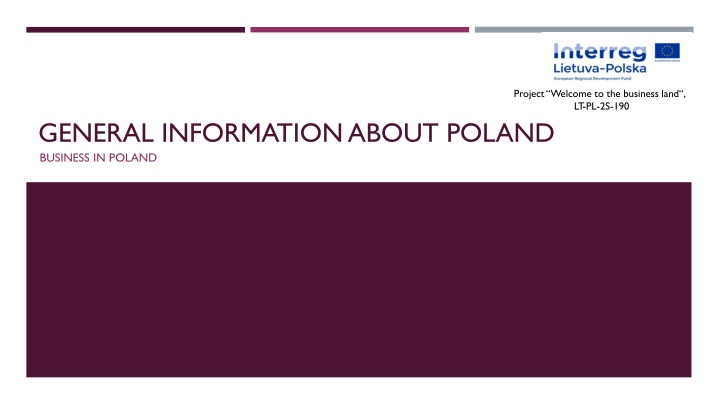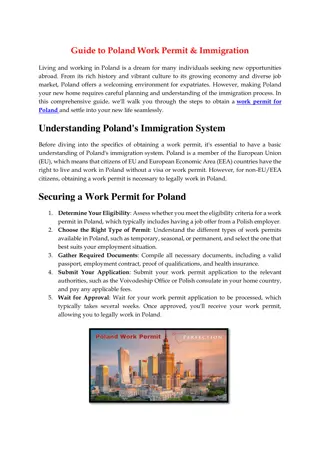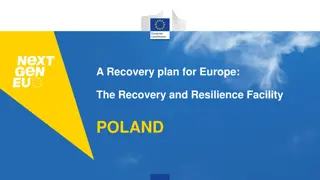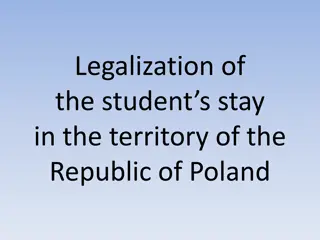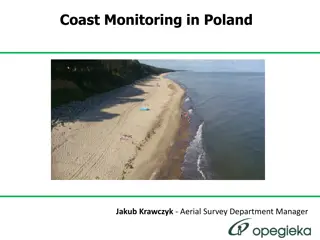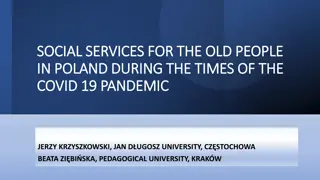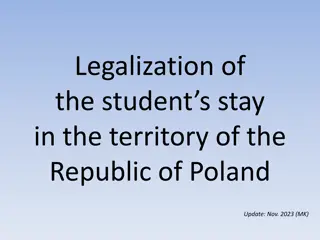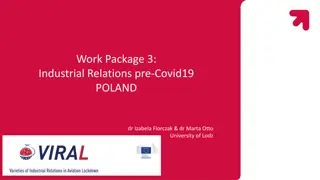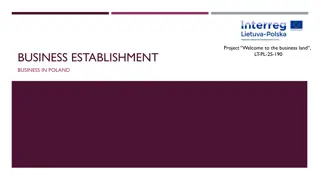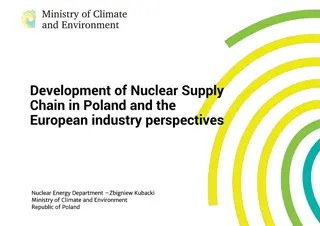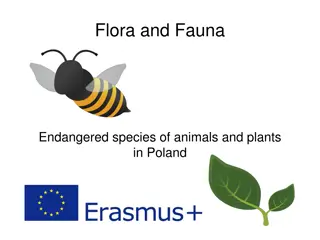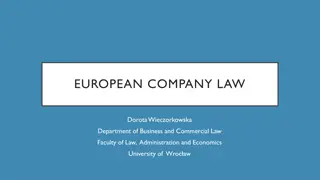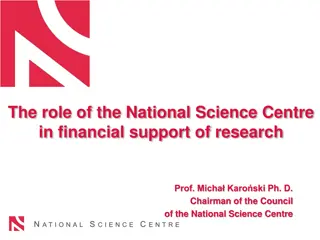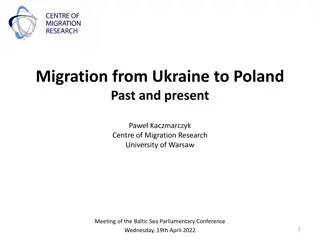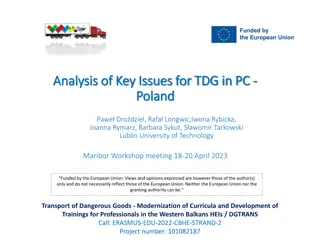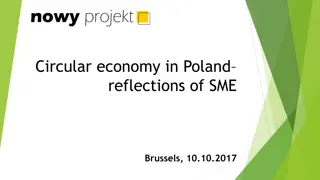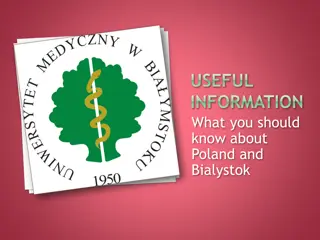General Information About Poland's Business Landscape
Poland, a country in Central Europe, boasts a rich history and diverse culture. Learn about its administrative divisions, key facts, and participation in international organizations. Discover the economic landscape and demographics of Poland.
Download Presentation

Please find below an Image/Link to download the presentation.
The content on the website is provided AS IS for your information and personal use only. It may not be sold, licensed, or shared on other websites without obtaining consent from the author.If you encounter any issues during the download, it is possible that the publisher has removed the file from their server.
You are allowed to download the files provided on this website for personal or commercial use, subject to the condition that they are used lawfully. All files are the property of their respective owners.
The content on the website is provided AS IS for your information and personal use only. It may not be sold, licensed, or shared on other websites without obtaining consent from the author.
E N D
Presentation Transcript
Project Welcome to the business land, LT-PL-2S-190 GENERAL INFORMATION ABOUT POLAND BUSINESS IN POLAND
FACTS ABOUT POLAND Area: 312 679 sq. km. Neighbors: Germany (land border 467 km) Czech Republic (border 796 km) Slovakia (border 541 km) Ukraine (border 535 km) Belarus (418 km) Lithuania (border 104 km) Russia (Kaliningrad) (land border 210 km)
FACTSABOUT LITHUANIA Language:Official language Polish Religion: Poland is considered to be very religious country: majority 87.58% consider themselves Roman Catholic. Currency: Polish z oty (PLN) Political system: Poland is a representative democracy, with a president as a head of state, whose current constitution dates from 1997. Poland ranks in the top 20 percent of the most peaceful countries in the world, according to the Global Peace Index. The government structure centers on the Council of Ministers, led by a prime minister. The president appoints the cabinet according to the proposals of the prime minister, typically from the majority coalition in the Sejm. The president is elected by popular vote every five years.
ADMINISTRATIVE DIVISION Poland is divided into 16 voivodships, which are further divided into smaller units called poviats, and poviats are made up of gminas. There are currently 379 poviats and 2478 gminas. Cities: The biggest cities in Poland: Warsaw 1 758 143 population Cracow 766 739 d 693 797 Wroc aw - 638 364 popl.
PARTICIPATION IN INTERNATIONAL ORGANIZATIONS Poland joined Organisation for Economic Co-operation and Development (OCED) on 22nd November 1996, Poland is a member of the North Atlantic Treaty Organization (NATO) alliance since 1999, On 1 May 2004,Poland became a full member of the European Union, Poland is also a member of: United Nations, The World Trade Organization, European Economic Area, International Energy Agency, Council of Europe, Organization for Security and Co-operation in Europe, International Atomic Energy Agency, European Space Agency, G6, Council of the Baltic Sea States, Visegrad Group, Weimar Traingle and Schengen Agreement
No. Voivodship Total in ha (31.12.201 5) the number of residents in mln (2016) 1 MAZOWIECKIE 3 555 847 5 285 604 COUNTIES NUMBER OF RESIDENTS 2 WIELKOPOLSKA 2 982 650 3 455 477 3 LUBELSKIE 2 512 246 2 171 857 4 WARMI SKO-MAZURSKIE 2 417 347 1 439 675 5 ZACHODNIOPOMORSKIE 2 289 248 1 710 482 6 PODLASKIE 2 018 702 1 188 800 7 DOLNO L SKIE 1 994 674 2 916 577 8 POMORSKIE 1 831 034 2 283 500 9 DZKIE 1 821 895 2 533 681 10 KUJAWSKO-POMORSKIE 1 797 134 2 098 370 11 PODKARPACKIE 1 784 576 2 128 687 12 MA OPOLSKIE 1 518 279 3 346 796 13 LUBUSKIE 1 398 789 1 018 084 14 L SKIE 1 233 309 4 626 357 15 WI TOKRZYSKIE 1 171 050 1 257 179 16 OPOLSKIE 941 187 996 011
DEMOGRAPHICS Population of Poland has been decreasing in the recent years The average birth rate is estimated at 342 463 and average death rate is 401 378. due to migration.
INTERNATIONAL IMMIGRATION OF RESIDENTS High level of emigration for temporary stay after 2004 (when Poland joined EU) to European Union countries (UK, Germany, Ireland, Netherlands, Italy): mostly young people repeated, circular migration
TRENDS OF MIGRATION IN POLAND Increasing immigration in recent years large immigration from Ukraine large scale of short-term immigration economic immigration (to work) immigration related to education Poland becoming an emigration and immigration country
EMPLOYERS STATEMENTS ON INTENTTO HIREA FOREIGNER Source: Statistics Poland, Migration statistics in Poland, 2018
ACCESSIBILITY - INFRASTRUCTURE Poland has a convenient location it is located in the center of Europe, at the intersection of main communication routes it is like a bridge between Western and Eastern Europe. This is a great advantage for potential investors they have an easy access not only to the Polish internal market (approximately 38 million people) but also to the markets in other European countries (over 0.5 billion people). Another advantage are benefits which come from participation of Poland in different global organizations like the European Union, United Nations or NATO. Poland is therefore potentially politically stable and has a significant position on the international arena. From an economic point of view Poland is also trustworthy, the economy was not as affected by the global crisis as the economies of other European countries, but has additionally strengthened its position in the CEE and Europeas a wholeduring the crisis.
THE MAIN MACROECONOMIC INDICATORS 2015 - 2018 Poland's Nominal GDP reached 142.8 USD bn in Mar 2018, compared with 155.4 USD bn in the previous quarter. Nominal GDP in Poland is updated quarterly, available from Mar 1995 to Mar 2018, with an average number of 85.2 USD bn. The data reached an all-time high of 155.4 USD bn in Dec 2017 and a record low of 31.4 USD bn in Mar 1995. CEIC converts quarterly Nominal GDP into USD. Central Statistical Office provides Nominal GDP in local currency based on ESA 2010. The National Bank of Poland average market exchange rate is used for currency conversions. Nominal GDP prior to Q1 2002 is based on ESA 1995. In the latest reports, Poland's GDP expanded 5.0 % YoY in Mar 2018. Its GDP deflator (implicit price deflator) increased 1.1 % in Mar 2018. Poland's GDP Per Capita reached 13,645.5 USD in Dec 2017. Its Gross Savings Rate was measured at 18.6 % in Mar 2018.
NEW ECONOMIC ENTITIES REGISTERED As of January 2018, 36 409 new economic entities were registered in Poland. Geographically economic entities are registered in the region of Mazowsze 16,2%, l sk 10,12% and Wielkopolska 9,81%. the majority of new Source: Centralny O rodek Informacji Gospodarczej. www.coig.com.pl
NUMBER OF BANKRUPTCY PROCESSES COMPLETED In 2017, the number of bankruptcies and restructuring of Polish companies amounted to 885 in total. 537 companies out of 885 declared bankruptcy. Restructuring proceedings introduced at the beginning of 2016 together with the new bankruptcy law are increasingly used. Their participation in all proceedings is growing - in 2017 it amounted to 39%, while in 2016 it was 27%. Among the restructuring proceedings, the most common are the accelerated arrangement proceedings (209) and the least observed are procedures for the approval of the arrangement (11).
ATTRACTIVE SECTORS Information and communication technology sector is one of the highly prioritised and most promising sectors in Lithuania. Over 31,500 IT professionals in Lithuania are working in this sector. Modern technologies (such as EDGE technology, 4G mobile communications infrastructure and mobile WiMAX 4G Internet), the fastest public Wi-Fi in Europe and the greatest fibre-optic (FFTH) Internet network penetration in Europe all these factors make Lithuania especially attractive for offshore services. Lithuania s engineering industry has been constantly growing and expanding by approximately 15% every year since 2009. This industry is highly competitive in terms of cost and quality and it is well-integrated into the global supply chains. Products developed by the Lithuanian engineers are often adapted by such international companies and organisations as NASA, Boeing, U.S. Army,BMW,Volkswagen,Hitachi,Siemens and Mitsubishi. Biotechnology research takes place in Lithuania, and the developed techniques and products are applied in the fields of medicine, pharmacy, chemistry, agriculture, environment, etc. Lithuania s biotechnology products are recognised worldwide, as 90% of them are exported to over 100 countries. The main export markets include the USA,Japan,Israel,Germany and the United Kingdom.The sector grows on average by 25% annually.
ATTRACTIVE SECTORS Source: Atradius Country Report Poland 2018
SOURCES Atradius Country Report Poland, 2018. Global_Bankruptcy Report, 2017. Centralny O rodek Informacji Gospodarczej. www.coig.com.pl EY. Doing Business in Poland, 2017. Polish Agency for Enterprise Development https://www.parp.gov.pl/ PricewaterhouseCoopers UAB.Doing Business in Poland, 2017. Statistics Poland, Migration statistics in Poland, 2018. Statistics Poland. http://stat.gov.pl/en/ World Bank. Doing Business Poland, 2018.
About the project The project Welcome to the business land (LT-PL-2S-190) is aimed at showing the border region youth that Business can be simple, if you have a good idea, some support from professionals and general knowledge on business processes. During its implementation, it is planned to organize business leader s competition and International Economic Forum and to activate partnership of project beneficiaries and social partners (schools, business companies, professional development centers). This training material has been produced with the financial assistance of the European Union. The contents of this training material are the sole responsibility of PI PVC and Euroregion Niemen Association and can under no circumstances be regarded as reflecting the position of the European Union. Total projects size is 49 973, 25 EUR. Out of them co-funding of European Regional Development Fund is 42 477,25EUR. This project is Partly financed from the European Regional Development Fund Interreg V-A Lithuania-Poland cooperation programme www.bonusLT-PL.eu
